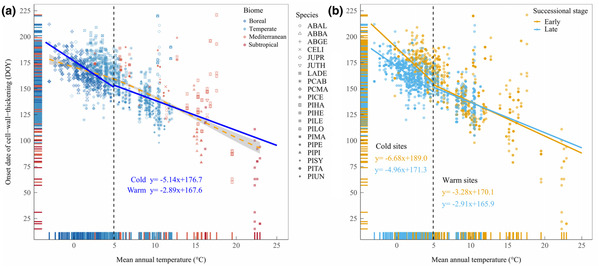Zhejiang University Scientists Discover Critical Thermal Transition Driving Spring Phenology Of Northern Hemisphere Conifers
On November 30, Prof. HUANG Jianguo’s team at the Zhejiang University College of Life Sciences published a research article titled “A critical thermal transition driving spring phenology of Northern Hemisphere conifers” in the journal Global Change Biology.
The advances in spring phenology are considered as a major imprint of climate change impacts across all terrestrial biomes. Secondary growth, or xylem phenology, is a key component of forest spring phenology. Although there is an increasing interest in predicting the shift of phenology, the advances in spring phenology due to global warming are open to debate. A wide spectrum of evidence regarding the advancement of spring phenology induced by global warming at different spatio-temporal scales points to a potential thermal threshold in response to global warming.
Prof. HUANG Jianguo’s team compiled a large and unique dataset of weekly cell-wall-thickening phenological measurements of 20 coniferous species from 75 sites over the Northern Hemisphere. These sites spanned across a broad mean annual temperature (MAT) gradient (-3.05 to 22.9℃) across the Northern Hemisphere (latitudes 23-66°N). The monitoring years varied among the sampling sites from 1998 to 2016. Along the MAT gradient, they identified a threshold temperature (using segmented regression) of 4.9 ± 1.1°C, above which the response of xylem phenology to rising temperatures significantly decline. This threshold separates the Northern Hemisphere conifers into cold and warm thermal niches, with MAT and spring forcing being the primary drivers for the onset dates (estimated by linear and Bayesian mixed-effect models), respectively.
The existence of a thermal threshold across ecosystems separates the biomes into regions with the different advancing rates of spring phenology under global warming: a larger advancement in cold sites and a smaller advancement in warm sites. With continuous global warming, a more uniform trend will be expected in terms of spring phenology between cold and warm ecosystems. At the species level, as early successional species showed a stronger advancing shift in cold sites than that for the late-successional ones, these two functional groups would shift further apart under rising temperatures. Hence, the cold ecosystems would face fundamental changes in the timing of cell wall thickening and the synchrony among tree species.
This study provides crucial evidence for integrating the identified thermal threshold into the Earth-System-Models for a more insightful understanding of spring phenology in response to global warming and a more accurate prediction of global climate-carbon feedbacks.

